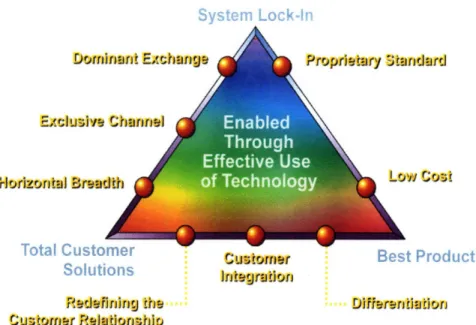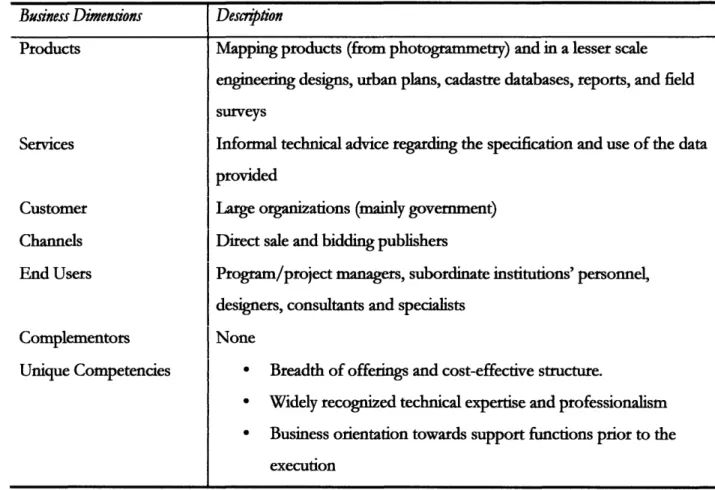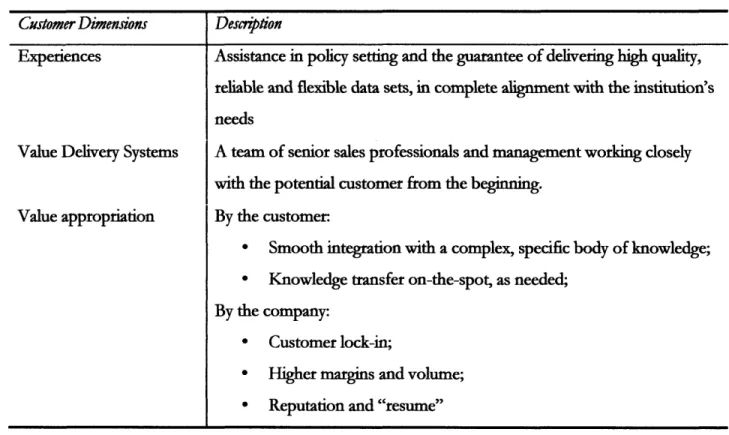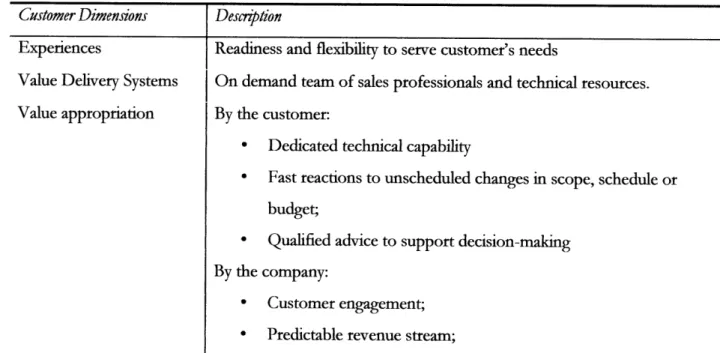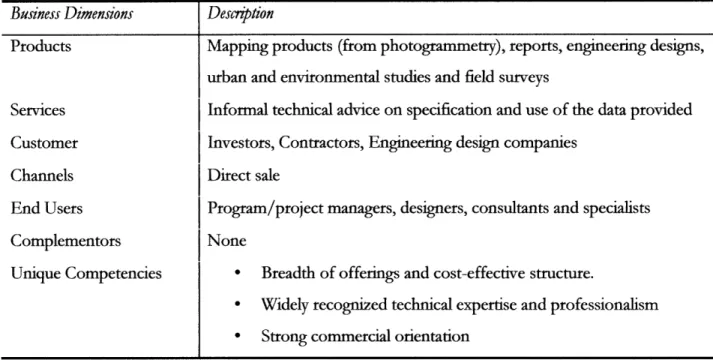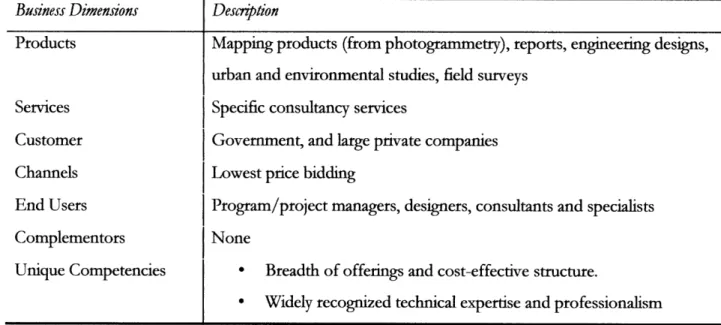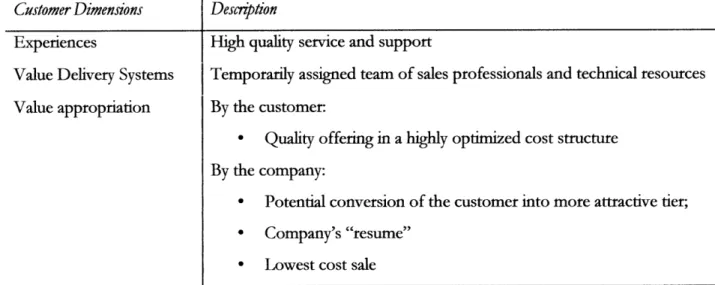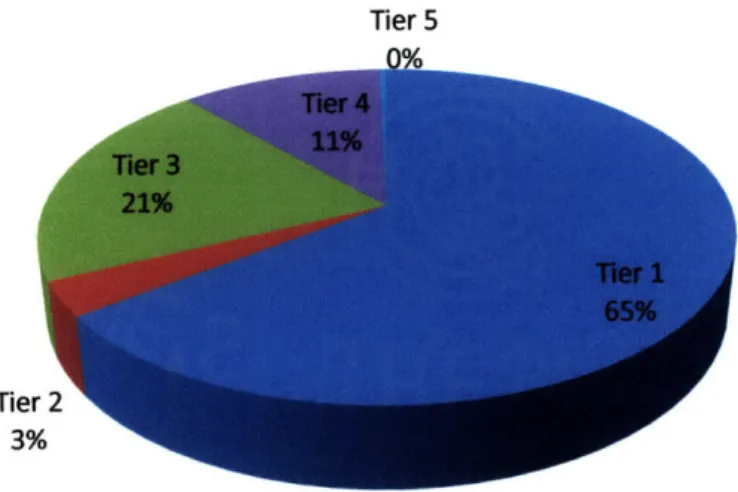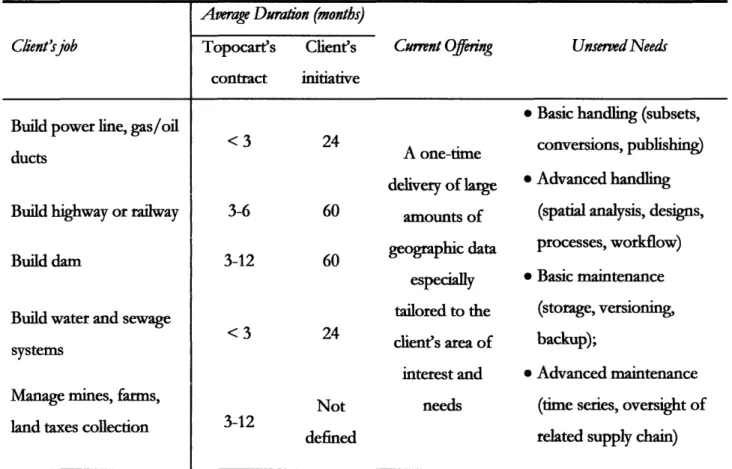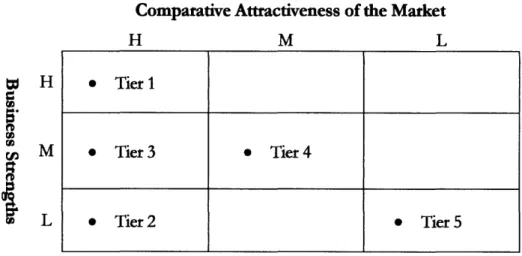DEVELOPING A GLOBAL STRATEGY FOR
A BRAZILIAN ENGINEERING SERVICES
PROVIDER
by
ABNER LIMA de OLIVEIRA B.S. Civil Engineering University of Brasilia, 1997
Submitted to the MIT Sloan School of Management in Partial Fulfillment of the Requirements for the Degree of
Master of Science in the Management of Technology
At the
Massachusetts Institute of Technology June 2008
MASSACHUSETTS INSTITUTE OF TEOHNOLOGY
JUN 2 5
2008
LIBRARIES
©2008
Abner Lima de Oliveira. All rights reserved. ".' ,The author hereby grant to MIT permission to reproduce and to distribute publicly paper and
electronic copies of this thesis document in whole or in part
in
any medium now know or
hereafter created.
Signature
of
Author:
Signature of Author:/
/,/IT
Slqan Sc•1ool of M agement
a/ 9, 2008 Certified By:
Accepted By:
Arnoldo C. Hax Alfred P. Sloan Professor of Management
/
/
/
Thesis Advisor
/
Stephen J. Sacca
Director, MIT Sloan Fellows Program in Innovation and Global Leadership
Amoldo C.
Hax
Alfred P. Sloan Professor
/
/ f
of Management
Thesis Advisor
DEVELOPING A GLOBAL STRATEGY FOR A BRAZILIAN ENGINEERING SERVICES
PROVIDER
by
ABNER LIMA de OLIVEIRA B.S. Civil Engineering University of Brasilia 1997
Submitted to the MIT Sloan School of Management on May
9th, 2008 in Partial Fulfillment of the Requirements for the
Degree of Master of Science in the Management of Technology
ABSTRACT
The Delta Model framework is used in this work to assess a engineering services provider's current and desired level of customer bonding and define a Strategic Plan towards a global operation. Several other frameworks serve as support for the setting of the strategic thrusts, helping select which competencies to export, where to operate and what to incorporate in each location. This thesis aimed at leveraging the company's current localized success to achieve a more sustainable position in today's economic world, more and more borderless and yet stage of important sources of geographic arbitrage and competitive advantage.
Thesis Advisor: Arnoldo C. Hax
AKNOWLEDGEMENTS
This work is a piece on the broader context of my professional and personal aspirations, in the pursuit of which I have been supported by extraordinary people I had the privilege to encounter throughout the journey. Without the pretension to settle my debt, I would like to express my recognition for their influence and share the particular achievement of graduating at Sloan with them.
My parents, Ubirajara and Vilma, the first leaders I had contact with, and ones tried harder than most of us will ever be, through the Brazilian "lost decade" (which for them lasted more than twenty years, with spillovers that are impossible to measure) and my brothers, Davi and Samuel, better men than me and soul mates forever. They are my examples of integrity and faith and their fight to survive underdevelopment throws me out of bed every morning and pushes me forward. Thanks for more than I could say.
My lovely wife Gisele, lifelong friend, safe haven to which I return happily after each battle to restore my confidence and strength. Thanks for coming with me wherever life takes us to and for being so happy with so little.
Jorge, an outstanding business leader taught by life and the owner of the largest and most passionate cohort of followers and admirers I ever thought was possible, and the "family" at Topocart, Claudio, Alberto, Lucio, Careca, Nercio, Plinio, Gil and some 200 special people and their families, that make our job more meaningful. Thanks for believing in me and betting high. This is for you.
To my exceptional classmates at Sloan and the stellar MIT faculty, particularly Joe Ferreira, Joe McCoughlin, Howard Anderson, Rick Locke, Pat Bentley and Andrew Lo, who humbled and inspired us to be better professionals and persons. And Arnoldo Hax, not only a professor, but a mentor who, as somebody once put it, makes you believe you are better than you really are. Thanks for your generosity.
My closest friends at Sloan, no need to name you, you know who you are. Thanks for fighting the daily battle with me through this year and for amazing me every time with your brightness, talent and
humanity.
Many thanks to Ricardo Betti, Luiz Leonardi, Antonio Barros de Arruda Castro, Odelcon Arruda and Stephen Sacca, remarkable people that worked hard to "align the stars".
DEVELOPING A GLOBAL
STRATEGY FOR A BRAZILIAN
ENGINEERING SERVICES
PROVIDER
ABNER LIMA de OLIVEIRA Sloan School of Management Massachusetts Institute of Technology 15.THG - Spring 2008
TABLE OF CONTENTS
T able of C ontents ...
...
7
List of Figures ...
10
List of T ables ...
11
1.
Introduction ...
13
2.
M ethodology...
15
2.1.
Introduction to the fram ew orks...
... 16
3.
O verview of T opocart...
21
3.1.
M apping and Survey...
...
22
4.
Strategic A nalysis...
...
24
4.1.
C ustom er Segm entation ...
...
24
4.1.1. Partner seeker...
...
24
4.1.2. T otal Solution seeker ...
... 27
4.1.3. N egotiated solution seeker ...
30
4.1.4. Large price seeker ...
...
32
4.1.5. Sm all price seeker ...
...
33
4.2.
Segm entation analysis...
...
34
4.2.1. Attractiveness and Strengths Analysis...
...
38
4.2.2. A closer look at attractiveness ...
...
... 39
4.3.
B undle of C om petencies ...
... 43
4.4.1. Product Scope... 52
4.4.2. Service Scope ...
... 53
4.4.3. Custom er Scope ... ... 57
4.4.4. End user Scope ... 59
4.4.5. Channel Scope ... 60
4.4.6. Com plem entors Scope...
61
4.4.7. G eographic Scope ...
... 62
4.4.8. U nique Com petencies ... ... 65
5.
G lobal Strategy ...
67
5.1.
Industry O utlook ... ... 67
5.1.1. M arket sim ilarities ... 69
5.1.2. Scale and scope econom ies ...
... 70
5.1.3. Comparative/Competitive advantages of locations ... 70
5.1.4. Regulation... ...
71
5.1.5. Conclusions ... 72
5.2.
The H om e Base ... ...
73
5.2.1. Factor (Input) Conditions ... ... 73
5.2.2. Context for Strategy and Rivalry ...
....
...
75
5.2.3. D em and Conditions ... ... 75
5.2.4. Related and Supporting Industries ...
...
...
76
5.3.
The Target Locations ... ... 78
5.3.1. Current G lobal Configuration ... 78
5.3.2. A N ew G lobal Base ... ... 81
5.3.3. Conclusions ...
85
5.4.
Exporting the Bundle of Competencies ...
85
5.4.1. Pre-sale Competencies ... ... 87
5.4.2. Post-sale Competencies ... ... 89
5.4.3. Conclusions ... 90
6.
Strategic Agenda ...
92
6.1.
Align and Complement Competencies ...
... 97
6.1.1. Define the W orkbench main offerings ...
98
6.1.2. Acquire resources to support the offerings...
... 99
6.1.3. Innovation Committee ... ... 100
6.2.
Build internal infrastructure ...
101
6.2.1. Implement technical resources ...
102
6.2.2. Implement administrative resources... 103
6.2.3. Incorporate the US office ... ... 104
6.2.4. Upgrade the Spain office ...
106
6.2.5. Improve Off-shore Supply Chain ...
108
6.3.
Capture Market Share...
109
6.3.1. Angola ...
110
6.3.2. Africa and Middle East ...
111
6.3.3. Brazil... ...
112
6.3.4. United States ... 113
LIST OF FIGURES
Figure 1 - The Delta Model strategic options (Hax & Wilde II, 2001) ... 16
Figure 2 - The dimensions of the Delta Model Triangle (Hax A. C., 2007) ... 18
Figure 4 - Mapping and Survey revenues per customer tier... ... 36
Figure 3 - Competitive position of each customer tier... ... 35
Figure 5 - Comparative Attractiveness versus Business Strengths... ... 38
Figure 6 - Mapping of differing customer attractiveness ... ... 42
Figure 7 - Customer Attractiveness (Tier 1) ...
42
Figure 8 - Topocart's existing bundle of competencies ...
... 47
Figure 9 - Topocart's desired bundle of competencies ...
... 50
Figure 10 - Brazil's regions... 63
Figure 11 - Level of globalization for the mapping industry (Yip, 1995) ... 72
Figure 12 - Porter's diamond for Topocart's home location, Brazil...
.77
Figure 13 - Bartlett and Ghoshal's configuration for Topocart (Home-based multinational).. 79
Figure 14 - Ferdows' strategic roles for Topocart's current locations...
80
LIST OF TABLES
Table 1 - Business dimension of Tier 1 - Partner seeker ... ... 26
Table 2 - Value proposition for Tier 1 - Partner seeker... 27
Table 3 - Business dimension of Tier 2 - Total Solution seeker...29
Table 4 - Value proposition for Tier 2 - Total Solution seeker ... 29
Table 5 - Business dimension of Tier 3 - Negotiated Solution seeker... ... 31
Table 6 - Value proposition for Tier 3 - Negotiated Solution seeker ... .... 31
Table 7 - Business dimension of Tier 4 - Large price seeker... 32
Table 8 - Value proposition for Tier 4 - Large price seeker ... 33
Table 9 - Business dimension of Tier 5 - Small price seeker... ... ... 33
Table 10 - Value proposition for Tier 5 - Small price seeker ... 34
Table 11 - Business potential on Tiers 2 and 3 (source: company information) ... 37
Table 12 - Two Cases of Differing Customer Attractiveness ... 40
Table 13 - Priority Assessment Scale for the Business Scopes ... ... 51
Table 14 - Priorities of the New Product Scope... ... 53
Table 15 - Challenges from the implementation of a Product Scope ... .... 53
Table 16 - Number of Contracts and Revenue Percentage per Tier, 2007 (source: company inform ation) ... 54
Table 17 - Priorities of the Existing Service Scope ... 54
Table 18 - Priorities of the New Service Scope ... ... 55
Table 20 - Priorities of the Existing Customer Scope ... 57
Table 21 - Priorities of the New Customer Scope ... 58
Table 22 - Challenges from the change in the Customer Scope...58
Table 23 - Priorities of the Existing End-user Scope ...
59
Table 24 - Priorities of the New End-user Scope ... 60
Table 25 - Priorities of the Existing Customer Scope ... 60
Table 26 - Priorities of the Existing Customer Scope ...
61
Table 27 - Priorities of the Existing Geographic Scope...64
Table 28 - Priorities of the New Geographic Scope...64
Table 29 - Priorities of the Existing Unique Competencies...
65
Table 30 - Priorities of the New Unique Competencies ...
66
Table 31 - CAGE analysis comparing Spain vs Florida, from the Brazilian headquarters perspective ...83
Table 32 - RATs test applied on the "pre-sale" set of competencies ...
... 87
1. Introduction
In a networked economy, national boundaries are no longer suited to confine a company's strategy or vision. A strategic positioning that crosses borders, building on location arbitrage, constitutes source
of a superior performance to the enterprise.
The present work aims at setting a comprehensive strategy for a leading Brazilian engineering services provider aiming at an expansion to foreign markets. The main motivations for this goal are listed below:
* The home-base market is not negligible but is, by definition, limited. The company has the ambition of capturing a share of the global expenditures in the industry;
* Foreign direct investments are growing steadily (Brazil was just awarded the S&P Investment Grade). This is likely to bring world-class competition to the company's doorstep. Success in an advanced market will help secure long term dominance in the home location;
* The internal market portrays heavily oscillating demand, forcing the company to bear increasing risk. The addition of more stable markets to the company's portfolio is likely to hedge the home demand risk;
This goal is supported by the following existing drives:
* The company's technologic status is au pair with the leading companies in the world;
* The company has in-house, world-class leadership and management to carry out the expansion;
* Currently, the company can self-finance the expansion;
* The current operation can scale to serve new demands, with adjustments;
The thesis is organized in four parts: Chapters 1 and 2 aim at the introduction of the structure of the work and the frameworks used; Chapters 3 and 4 dissect the current operation under the Delta Model's lenses; Chapter 5 discusses the why, what, where and how to expand globally and Chapter 6 presents the proposed detailed strategy for the global expansion.
2. Methodology
In order to achieve sustainable success in its internationalization drive, the company is looking to develop a winning strategy, composed of:
* A careful assessment of the home-base strategy to enable a close alignment with the international growth plans. The Delta Model will be used to assess the current level of customer-orientation, assess hidden opportunities and envision desired competencies guiding the whole organization (and not only a part of it) towards superior customer bonding.
* The analysis will be complemented by the application of the Lessard's RATs framework to define which competencies are applicable in the global marketplace;
* A study of the home-base intrinsic conditions that might hinder the expansion initiative with the goal of defining actions to offset those shortcomings (Porter's diamond). The "virtual diamond" will be used to determine which complementary resources should be sought abroad. * A careful evaluation of which advanced markets are more prone to an approach, given cultural, administrative, geographic and economic gaps with the home-base market. Ghemawat's CAGE distance framework will guide the assessment;
2.1. INTRODUCTION TO THE FRAMEWORKS
This chapter describes the main characteristics of the frameworks used. Far from constituting an
extensive review of the available bibliography on the matter, it will provide the reader with a glimpse
of this work's analytic mechanics.
The Delta Model (Hax & Wilde II, 2001) introduced the premise that the only sustainable way to
achieve superior market profitability and share is by seeking customer bonding. It expands the
common product-centric approach to a customer-centric vision that is free from established
perceptions of the customer's needs (notably the competitors') and opens a path for true innovation in
the offerings. The Delta Model presents three possible strategic positioning options for the company
(see Figure 1).
System Lock-in:
competition based upon system economics
Total Customer Solutions:
competition based upon customer
Best Product:
competition based upon product
economics economics
Each position and its dimensions (Figure 2) are described briefly below:
* Best Product: the customer is attracted by intrinsic characteristics of the offering, which usually fall under one these two dimensions:
o Low cost: providing the lowest cost, without any product differentiation. Usually unsustainable since low cost sources keep moving around from company to company;
o Differentiation: while securing cost effectiveness, bringing about important differentiation in the offerings in order to enjoy profits that are superior to competitors'. This option is not immune from benchmarking, which results in thin sustainability
* Total Customer Solutions: the opposite approach from Best Product, enables the provider to create individual relationships with the clients and directly influence their economic value generation, requiring a deep understanding of the customer base. The following dimensions are possible:
o Horizontal Breadth: the company covers entire spectrum of customer needs allowing it to market itself as a "one-stop-shop";
f)rr
EUlusive
rizo~-ntls Brea.
TseR C-,,+
aL
to ,u=•Ston So utions Cus•tomeb r Best Productrntoauin
Cu!mrf)~ Relationrship
Figure 2 - The dimensions of the Delta Model Triangle (Hax A. C.,
2007)
o Customer Integration: extending the offerings to replace or leverage tasks currently
under the client's responsibility. Includes outsourcing but goes beyond by adding clear
value through the application or transfer of specific knowledge (the company's bundle
of competencies).
o Redefining the customer experience: it is enabled by a focus on the "experience of
the customer" from the acquisition moment to the entire lifetime of the offering.
Requires a complete customer segmentation and the capacity to offer a customized
approach to each tier;
* System Lock-In: this position is available to the "extended enterprise" (the company, the suppliers, the customers and the complementors) which must seek at least one of the following dimensions:
o Exclusive Channel: the company occupies a space where barriers exist in such an extent that they prevent competitors to try and access the customer base. This position is usually constrained by public policies;
o Dominant Exchange: the company successfully puts in place an exchange interface
with its client base that and locks competitors out. Requires the interface to be largely adopted relevant in terms of users;
o Proprietary Standard: the least accessible of all the positions, is achieved when the company reaches a critical mass of complementors, whose offerings are meant to work together with the companys'.
The highly instrumental setup of the Delta Model Integrated Framework makes it suitable to a practical, hands-on strategy-setting process. The steps are summarized below:
* Customer Segmentation and Customer Value Proposition: identification, description and classification of the different customer tiers served by the company, the value proposition offered to each and untapped opportunities;
* Mission of the Business: the statement of the existing and desired business dimensions of the firm;
* The Strategic Agenda: the list of the necessary and desired thrusts, based in the Mission, with the definition of components and leaders;
To better support the definition of a Strategic Agenda, the final product of this work, the following frameworks will be applied to Topocart's global expansion project:
* Lessard's RATs framework constitutes a strong complementor for the Delta Model analysis since it provides the grounds for assessing whether the existing and desired competencies are Relevant to the new markets, Appropriable by the company in these new environments and Transferrable to the external locations.
* Porter's Diamond (Porter, 1990) acknowledges the importance of location components to the success of an internationalization venture, and puts together an assessment of a business' home-base capability through four dimensions - the "Diamond" - Factor Conditions, Context for Strategy and Rivalry, Demand Conditions, Supporting and Related Industries, and the need for adding competencies to offset potential shortcomings.
* Ghemawat's CAGE framework (Ghemawat, 2007) seeks to determine a weighted "distance" composed of Cultural, Administrative, Geographic and Economic (CAGE) factors in order to anticipate the degree of compatibility between the home-base and the desired new territory and, therefore, the internationalization initiative's chance of success.
3. Overview of Topocart
Topocart is a fast growing professional services company located in Brazil, with its headquarters in Brasilia, the nation's capital. Its business scope encompasses mapping, survey, engineering, urban planning and environmental studies.
Topocart was founded in 1991 by a retired Army colonel, Jorge Arteiro, to provide topographic survey services, in Brasilia, Brazil's capital. A graduate from the Army's academy, specializing in Cartography, he had led some of the most important mapping and infrastructure building efforts in Brazil, once responsibility of the Armed Forces. The company transitioned to its current stage in 2001, when the first photogrammetric job was taken. In 2003, it purchased its first mapping aircraft becoming self-sufficient in terms of cartographic production. Having grown four times since then, Topocart found itself thriving to find a coherent strategy that would leverage on its set of values and investment
capacity to achieve a sustainable growth and reach the top of its market.
Currently, the company has 200 employees and offices in Brasilia, Rio de Janeiro, Fortaleza, Natal, Recife and Belo Horizonte. It operates primarily in three Brazilian regions (North, Northeast and Midwest) encompassing 19 of the 26 Brazilian states.
We are the most important player in our region of operation, which has been highly prioritized by government investment. In the Southeast (the richest states) we compete against strong players and a myriad of smaller offices. We have little penetration in the South, also an important pole of investment and development.
The majority of the company's revenues come from Mapping and Survey offerings, which also make
the bulk of its competencies. Not coincidently, this is the field by which the company is most
recognized.
3.1. MAPPING AND SURVEY
Mapping is one of the most ancient human activities, being tracked back to the Egyptians measuring
their culture parcels before every high tide period of the Nile. The calculations helped preserve each
owner's land's size and position even after the water had destroyed all material marks. Nowadays,
although electronics, optics and computers revolutionized the methods and expanded the possibilities,
the science is still based on the geometric principles developed centuries ago.
Customers looking for Mapping and Survey services usually need to recreate their working area in a
computational environment, in order to execute decision-making, analysis, designs and plans. The
main commonality is the need for very precise 3D representation of the existing features. Applications
range from crop management to infrastructure design.
The business knowledge domain can be roughly described as follows:
Topography: the great-great-grandson of the Egyptian geometry, employs high precision
optics and laser beams to calculate angle and distances between significant points in the
working area (for example, manholes, trees, buildings' comers) in order to determine their
location and size. After some processing, the measurements are converted into absolute
coordinates and the features are graphically represented. It provides the most detailed and reliable results, but it's only feasible when applied to limited areas.
* Photogrammetry: it's based on the fact that the human brain is capable of composing a 3D environment from slightly different images fed to each eye. Special cameras assembled in airplanes cover the area of interest with overlapping pictures which, through complex spatial geometry calculations, "recreate" the reality in a high precision 3D model. This model is converted, through human interaction, into standardized graphics that depict what has been recorded on the photos. Ultimately, the photos themselves are corrected from their central perspective and composed into a seamless background which enriches the map presentation.
* Other remote sensors: Other meaningful geographic data can be obtained through an array of airborne or orbital sensors. The LiDAR emits a laser beam towards the ground and by measuring its travel time determines, with a myriad of high precision points, the shape of the surface, and its coverage. Satellites fly at an altitude of hundreds of miles and can record information in up to 2-feet resolution images, although with little or no 3D capacity.
* Geographic information systems: integrating the geographic data collected or generated into a client's processes and systems is the most promising activity in the business. The domain encompasses theories, practices, software and IT infrastructure. The internet and the client's existing database systems are commonly utilized as platform for the development of spatial applications that will add geographic intelligence to the end-user's business.
4. Strategic Analysis
The goal of the Strategic Analysis is to look at the company's current experience in its home-base market and identify the degree of customer bonding as well as untapped opportunities within its current business model. The conclusions drawn will serve as input to the global strategy setting process.
4.1. CUSTOMER SEGMENTATION
The first step was to collect data from the contracts of the past three years and define a segmentation pattern. The commonalities between clients became clear when we separated them by purchasing attitude and potential value-added by the firm. Five tiers were identified and their description is presented below.
4.1.1. Partner seeker
This customer (usually government institutions) is commonly involved in very long term policy implementations and is looking for reliable and flexible suppliers. The bonding with this client is the highest possible because our capabilities complement their lack of resources from the very beginning all the way to the final delivery. Informal consultations are made prior to the formal contract period with the goal of providing technical advice. The execution phase is usually prone to changes in specification and scope to which the company has to respond quickly in order to secure the deadlines and budget allocated, usually highly constrained in amount and time of use.
Although advantageous for both parties, this relationship portrays several hiccups, which restrain its potential:
* The bidding and contracting processes usually take an unpredictable amount of time to complete, during which policies or priorities might change. Cancellations of bids are not uncommon;
* Despite the amount of consultations prior to contracts, the decision-maker has no power to choose the actual provider, so the depth of the bonding is not directly connected to the actual number of awards, although participation in the discussion process gives a deep understanding of the client's needs, which yields better proposals, increasing our chances in the bid.
* The decision-makers' views not always translate into reality due to the large number of bureaucratic levels that the bidding process has to go through. It is not unlikely for a bid's published content to come as a surprise to its own author;
* The tenure of the decision-maker is determined by politics, so how "long-term" the relationship will really be is unpredictable. A constant effort to keep track of the changes and to repair the ties is necessary;
Business Dimensions
Desnzption
Products Mapping products (from photogrammetry) and in a lesser scale engineering designs, urban plans, cadastre databases, reports, and field surveys
Services Informal technical advice regarding the specification and use of the data provided
Customer Large organizations (mainly government)
Channels Direct sale and bidding publishers
End Users Program/project managers, subordinate institutions' personnel, designers, consultants and specialists
Complementors None
Unique Competencies * Breadth of offerings and cost-effective structure.
* Widely recognized technical expertise and professionalism * Business orientation towards support functions prior to the
execution
Table 1 - Business dimension of Tier 1 - Partner seeker
There is an important gap between the client's and the company's knowledge, which constitute an opportunity for a long-lasting relationship with the institution, and one not so dependent on the individual views of its head people. However, this is hard to achieve due to the lack of a efficiency-seeking culture and a deep misalignment between the lower echelons (lifetime employees enjoying unrestricted tenure) and top management (politically-appointed managers).
Despite all these shortcomings, this tier lives up to its positioning in the triangle (see Error. Reference
ource not found.) and is responsible for the largest retention and the majority of the revenues. The
company's location, in the country's Capital, contributes to more streamlined consultations. These customers are likely to be locked-in once well-served and, while they cannot hire the company of their
choice directly, they become frequent advice-seekers, fact that translates into solid reputation for the company.
Customer Dimensions
Desoiption
Experiences Assistance in policy setting and the guarantee of delivering high quality, reliable and flexible data sets, in complete alignment with the institution's needs
Value Delivery Systems A team of senior sales professionals and management working closely with the potential customer from the beginning.
Value appropriation By the customer
* Smooth integration with a complex, specific body of knowledge; * Knowledge transfer on-the-spot, as needed;
By the company:
* Customer lock-in;
* Higher margins and volume;
* Reputation and "resume"
Table 2 - Value proposition for Tier 1 - Partner seeker
4.1.2.Total Solution seeker
Customers in this tier are usually private companies either investing or directly managing projects and programs which span a long-term schedule. Similarly to Tier 1's case, this customer extracts value from developing a lasting relationship with a supplier. But, by being privately-owned, they usually enjoy a greater freedom in choosing the suppliers and are reasonably aligned towards the highest efficiency setting possible. Also, they understand our value proposition enough to be able to demand a chain of services during the whole duration of their specific job (for example, the construction of a dam). Although this is usually a returning customer, what distinguishes them from Tier 3 customers is that
each contract spans a longer time, covering different phases of their project. The contracts in this tier display reasonable margins and highly predictable revenues, being regarded within the company as a "superior" way to serve the customer.
Despite its attractiveness, this tier does not yield a strong revenue stream. The reason is that, although this kind relationship has the potential to return a high value to the customers, still very few figure that out by their own, mainly because of:
* Lack of procurement processes enabling long term relationships with suppliers;
* Lack of field knowledge/experience;
* Lack of trust in the suppliers' capacity of delivering the full potential value (fear of being locked in a bad deal);
* Lack of awareness of the suppliers' capacity of delivering value;
* Dependency on long-established practices;
* Lack of long-term vision or alignment, in the corporate level;
Although many of the reasons are structural and cultural, the company could be proactively educating potential Tier 2 customers amongst its customer-base (mainly Tier 3), which it is not doing currently. Most of the challenges listed above are related to an information gap, which suggests that there are untapped opportunities.
Business Dimensions
Products Services Customer Channels End Users Complementors Unique CompetenciesMapping products (from photogrammetry), reports, engineering designs
and field surveys
Informal technical advice on specification and use of the data provided
Investors, Contractors, Engineering design companies
Direct sale
Program/project managers, designers, consultants and specialists
None
* R dt f ffc i; d i
ea o o ern g
s an cost-e ectve structure. Widely recognized technical expertise and professionalism
Strong commercial orientation
Table 3 - Business dimension of Tier 2 - Total Solution seeker
Customer Dimensions
Experiences
Value Delivery Systems
Value appropriation
Desrinption
Readiness and flexibility to serve customer's needs
On demand team of sales professionals and technical resources.
By the customer:
* Dedicated technical capability
* Fast reactions to unscheduled changes in scope, schedule or
budget;
* Qualified advice to support decision-making
By the company:
* Customer engagement;
* Predictable revenue stream;
Table 4 - Value proposition for Tier 2 - Total Solution seeker
4.1.3.Negotiated solution seeker
This tier encompasses the majority of the private companies we serve. They are new or returning customers that, because of our expertise and reputation, rely on us to define the most efficient data set for their project and deliver it with quality and on time. They are likely to be good candidates for additional consultancy after the final deliverables, but that currently happens in a "ad hoc" manner, and is commonly not charged.
These clients portray a superficial understanding of our field of knowledge, and are likely to have a difficult time extracting value from the huge amount of data we usually generate. They are frequently demanding and fast decision makers. Once they find that our advice is oriented to their best interest (a golden rule for our commercial operation) and that we can deliver what they need, they become returning customers. We have been very successful in building a returning customer-base. Although that relationship is likely to last, sometimes evolving to personal friendship between counterparts, the frequency and amount of contract awarded is highly cyclical, and depends on externalities such as government priorities and economic situation. Very few companies invest on their own and, therefore control the contracting agenda.
These customers are also early adopters of new technologies, but rarely provide a strong enough revenue stream to drive the company's investment in new technologies. The investment agenda is influenced the most by government opportunities, which lag behind the forefront of innovations. The result is a lag between Tier 3 customer's demand and the company's technological status. This gap is being closed by recent and ongoing rounds of investment, but still exists.
Business Dimensions
Products Services Customer Channels End Users Complementors Unique CompetenciesMapping products (from photogrammetry), reports, engineering designs, urban and environmental studies and field surveys
Informal technical advice on specification and use of the data provided Investors, Contractors, Engineering design companies
Direct sale
Program/project managers, designers, consultants and specialists None
* Breadth of offerings and cost-effective structure.
* Widely recognized technical expertise and professionalism * Strong commercial orientation
Table 5 - Business dimension of Tier 3 - Negotiated Solution seeker
The main challenge in this tier is to move customers up (to Tier 2). Tier 3 customers aren't usually upgraded to Tier 2 because the company's involvement level doesn't change on each contract. The challenge remains in convincing these customers that an enhanced relationship is likely to deliver superior value. Given the long-term duration of these customer's projects, opportunities abound.
Customer Dimensions
Experiences
Value Delivery Systems Value appropriation
Descrption
Expert advice, turn-key delivery
Temporarily assigned team of sales professionals and technical resources By the customer:
* Optimization of cost and high quality offerings in a crucial, foundation phase of the customer's job
By the company:
* Customer engagement (returning customer); Table 6 - Value proposition for Tier 3 - Negotiated Solution seeker
4.1.4.Large price seeker
Customers in this tier are currently unserved by us, but bear enough business potential to raise the
company's interest. New business development initiatives have also fell in this category in the past.
The company carefully chooses which opportunities are worth pursuing, and generally engage in pure
price negotiations, usually the customer's preferred procurement process. The main objective is to
expand the business beyond the first contract, from a more privileged standpoint. The most successful
initiatives yield a Tier 1-3 type relationship. Another goal is to build the company's resume with
currently inexistent capabilities.
The company does not pursue a low-price strategy commonly. It, however, is prepared to wage price
wars in selected opportunities, which add more value than the pure economic profit and don't
jeopardize the company's commercial positioning.
Business Dimensions
Descrption
Products
Mapping products (from photogrammetry), reports, engineering designs,
urban and environmental studies, field surveys
Services
Specific consultancy services
Customer
Government, and large private companies
Channels
Lowest price bidding
End Users
Program/project managers, designers, consultants and specialists
Complementors
None
Unique Competencies
* Breadth of offerings and cost-effective structure.
* Widely recognized technical expertise and professionalism
Customer Dimensions
Description
Experiences
High quality service and support
Value Delivery Systems
Temporarily assigned team of sales professionals and technical resources
Value appropriation
By the customer:
* Quality offering in a highly optimized cost structure
By the company:
* Potential conversion of the customer into more attractive tier;
* Company's "resume"
* Lowest cost sale
Table 8
-
Value proposition for Tier 4
-
Large price seeker
4.1.5.Small price seeker
The weakest bond with customers is observed in this tier. Their contracts are usually very small, and the company doesn't hold clear advantages against small offices and autonomous professionals. Very little bidding takes place and revenue stream is non-significant. The tier is regarded as important to "keep doors open" and build ties with the immediate community.
Business Dimensions
Products
Services
Customer
Channels
End Users
Complementors
Unique Competencies
Descnption
Field surveys and small publishing jobs
None
"Walk-in" customers, small companies
Direct sale (responding to consultations)
Program/project managers, designers, consultants and specialists
None
* Reputation, technical expertise and professionalism
Customer Dimensions
Experiences
Value Delivery Systems Value appropriation
Descipftion
High quality service and support
Temporarily assigned team of sales professionals and technical resources By the customer:
* Quality offering in a highly optimized cost structure By the company:
* Connection with the surrounding community
Table 10 - Value proposition for Tier 5 - Small price seeker
4.2. SEGMENTATION ANALYSIS
The segmentation proposed in this section was cross-referenced with the company's customer base in
order to provide a reality check and an opportunity to dig deeper in each tier's specific characteristics.
A classification of the company's contracts in each tier was undertaken. The classification was
narrowed to last year's customers, to reflect the most current situation and support more realistic
analysis. Figure 3 shows the tier's positioning in relation to the Delta model Triangle and highlights
their main characteristics. Figure 4 shows each Tier's participation in the revenues originated by the
Mapping and Survey business.
Tier 1 dominates the revenue generation, which copes with its bonding capabilities. In addition, there
is a reinforcing relationship in the way the company approaches this tier that can't be ignored. Because
of the amount and frequency of the opportunities in the government (the main infrastructure investor
in Brazil), it is regarded as a high potential client base. Each opportunity in this tier also demands more
in terms of general commitment because of the requirements and regulations of the public institutions'
procurement process. Therefore, the company's sales operation is heavily oriented towards this tier. This explains not only the dominance of government-related revenues (64% in 2007) but also the relative weakness of Tier 2's and 3's pipelines, based on private companies.
rihr 2: Total Slutio-Sekr
*"Umbrella" contracts, usually long term;
*High interest for the company
*Company needs to diversify offerings in this area and market it proactively
Fier 3: Negodatul Suludea-Seeker *Second largest revenue stream, but
high cyclical;
*Large contingent of returning
customers
* High interest and strength enable leading position
Figure 3 - Competitive position of each customer tier Her 5: Small Price-Seeker
nues, "walk-in" contracts
)y local offices;
against local competitors; st and little strengths
rier 1: Partner seker
*Largest revenue stre *Mainly government *Also, high cyclical; *High interest and do
4: Large Price-Seeker
Gateway to untapped markets or clients
Important for building company's resume
Moderate interest and limited strength
since company does not market itself as low-price
Tier 5
Tie
3
Figure 4 - Mapping and Survey revenues per customer tier
As it became clear by the segment's description, these two tiers hold an important business development potential, which can be tapped through a deep involvement in the client's "job". A measure of the business potential of Tiers 2 and 3 can be expressed by comparing differences current offerings and the customer's tasks (Table 11). Usually, the customer struggles with the complexity and volume of the data we provide while undertaking these tasks. An important cohort is so unprepared to tackle them that their job suffers from bad execution and falls short of the expectations. This could extend the company's involvement from a small period in the beginning to a strong participation (in different levels) in the project's entire lead time.
Average Duration (months)
Clent'sjob
Topocart's
Client's
Current Offering
Unserved Needs
contract initiative
* Basic handling (subsets,
Build power line, gas/oil
< 3
24
conversions, publishing)
ducts A one-time
delivery of large
* Advanced handling
Build highway or railway 3-6 60 amounts of (spatial analysis, designs,
Build dam 3-12 60 geographic data processes, workflow)
especially * Basic maintenance
Build water and sewage tailored to the (storage, versioning,
< 3 24 client's area of backup);
systems
interest and * Advanced maintenance
Manage mines, farms, Not needs (time series, oversight of
land taxes collection 3-12
defined related supply chain)
Table 11 - Business potential on Tiers 2 and 3 (source: company information)
Tier 4 benefits from both the company's alignment with government procurement processes and the effective cost structure, allowing for very low friction. In fact, the customer acquisition processes related to this Tier are the easiest to undertake, since no strong relationship is required and the bidding process displays a fraction of the regular bids' complexity. These are the main reasons for the financial strength of its position (surpassing Tier 3, for example, despite having lesser bonding potential).
4.2.1.Attractiveness and Strengths Analysis
Each tier displays a different attractiveness to the company and is approached by a particular set of
strengths. Tiers 1, 2 and 3 are highly attractive but the company is not equally strong in all of them.
Tier 4 sits in an intermediate position and tier 5 is in the low-end of the Attractiveness vs. Strength
matrix (Figure 5).
The company is well positioned to serve Tier 1 (Partner seeker), a highly attractive cohort. The main
competitors are the largest Brazilian firms (Esteio and Engefoto) which possess strong pre-bid
consulting capabilities and share a similar general orientation towards serving this customer base.
Tier 2 (Total Solution Seeker) is a highly attractive market, but the company's rather passive approach
has resulted a weak positioning. We suffer competition both from the large, structured firms and from
smaller, aggressive players (like Aeroimagem, Maplan and Digimapas) and since no differentiation is
perceived besides the company's reputation, rivalry is fierce and, not rarely, price-centered.
Comparative Attractiveness of the Market
H
M
L
Figure 5 - Comparative Attractiveness versus Business Strengths
* Tier 1
* Tier 3
* Tier 4
Tier 3 (Negotiated Solution Seeker) displays a stronger position than Tier 2 and is as attractive. This is because the customer's regular procurement process already supports the type of contracts usually awarded in this tier, which is not always the case in Tier 2. The company has a significant returning customer base in Tier 3, result of its reasonable business strengths (reputation, excellence and cost-effectiveness). Still, a more active approach is likely to differentiate the company against its current competitors and increase the chances of moving customers to Tier 2.
Tier 4 (Large Price Seeker) in an intermediary position in both dimensions, because it is regarded as a gateway to new accounts. Being a temporary position, it has been regarded a secondary priority in terms of building competencies and market power.
Tier 5 (Small Price Seeker) has no justification to be kept except for its role of integrating the local office with the surrounding community.
4.2.2. A closer look at attractiveness
As discussed earlier in the section, Tiers 2 and 3 are populated with a customer base with important unserved needs. It is crucial to understand the subtleties that differentiate these needs. From the company's past experiences, four dimensions were identified:
* Job Duration: Since the data provided by the company is commonly the foundation for the customer's job and supports its full development from beginning to end, the total job's duration is a good measure of the untapped business potential. Table 11 demonstrates that gap for common jobs.
* Job Complexity: The importance and depth of the geographic domain within the customer's
job and the tasks' complexity determine the solution's level of sophistication and drives value
addition and rent appropriation.
* Resources Alignment: The customer's level of technological maturity plays an important role in each opportunity's attractiveness. The more IT-oriented is the organizational culture the larger the breadth of offerings possible.
* Capacity Gap: The distance between the customer's and the company's resources, including knowledge, experience, people, systems, is a factor that directly influences attractiveness.
To better illustrate these dimensions, two cases are explored below.
Customer 1 Customer 2
Customer's final job Dam construction Railroad construction
Job Duration
Aprox. 5 years
3-5 years
Job Complexity High Medium
Resources Alignment High Low
Capacity Gap Small Large
Table 12 - Two Cases of Differing Customer Attractiveness
To enable comparison, both customers belong to Tier 2 (Negotiated Solution Seeker). The customers' final jobs are both related to infrastructure (construction of a dam - Customer 1 - and a railroad
-Customer 2) and the company provided them with a complete set of cartographic data, aimed at the planning and management of the job. Both include changing the occupation of large areas, impacting
the environment and inhabitants and involve legal and social issues. The jobs' complexities are similar, although the dam construction holds primacy and it is also likely to last longer than the railroad's in this particular case (this is related to the size and location of the enterprises, not necessarily to its nature). In terms of Resources Alignment, Customer 1 doesn't possess sophisticated IT resources and trained personnel. It is also very unlikely that those resources will be acquired during the project, due to cultural, organizational and structural factors. Customer 2 is much more IT-oriented and has capable people, enabling the application of advanced solutions and an extended value addition. Finally, Customer 1 has less in-house cartographic capacity than Customer 2. This is driven mainly by the lack of specific knowledge and experience but is also influenced by the customer's IT orientation. Figure 6 makes it clear that although Customer 1's job (the dam) is more attractive in duration, complexity and capacity gap, the lack of resource alignment is likely to hinder the company's efforts to deliver a comprehensive value proposition. This is not the case of Customer 2 (the railroad builder) where integration is easier and the other dimensions contribute to a higher attractiveness. Therefore, despite the apparent superiority of Customer 1's job, the company might extract more value from Customer 2's as Figure 6 makes clear.
Job
Complexity
Capacity Gap
ob
Duration
Resources
Alignment
-+Customer 1
-E-Customer 2
Figure 6 - Mapping of differing customer attractiveness
Similar approach can be used in Tier 1. However, customers in this tier display a smaller range for each dimension therefore the analysis is confined to certain limits as shown in Figure 7.
--$Lower
bound
Duration
-U-Higher
bound
Resources
Alignment
Figure 7 - Customer Attractiveness (Tier 1)
42
Capacity
Government customers deal with long-term, complex initiatives and portray large capacity gaps. But, just as the Customer 2 example above, the lack of alignment makes it very hard to deliver improved value propositions. The challenges customers in Tier 1 face were described in 4.1.1.
The opportunities in Tier 4 are usually not prone to a unified analysis and depend on a very particular set of circumstances therefore demanding a case-by-case decision making process.
4.3. BUNDLE OF COMPETENCIES
Along the years Topocart has built a set of abilities that are the basis for its current success. Although the majority of those aimed to improve operational effectiveness, they constitute an important base for the development of a customer-centric strategy. The existing set of competencies is discussed below:
* Best Product
o Low cost: The company's operation is dependent on resources that either display high substitution costs (such as the need for skilled technical people, trained for six months before becoming productive) or are subject to an unpredictable work schedule (such as the aircrafts and the high-value sensors they carry, which can only operate under perfect weather, in order to assure high quality outputs) making it very difficult to cope with the widely variable demand and to keep cost under control. To tackle that, the company has built a low-cost supply network based in Asia and Latin America and achieved a superior cost and productivity position in the in-house production phases.
In addition, the company has invested in acquiring technologies that enable higher productivity, reducing the operational risk imposed by the weather. Although the company has no policy in place regarding a low cost market approach, it is able to use its cost advantage in selected opportunities, such as the ones particular to Tier 4 or in accessing new markets;
o Differentiation: With its methods and theories going back to more than a hundred years, cartography production companies try to differentiate themselves by area of expertise, use of the latest technology and reputation. In terms of expertise, the company, instead of focusing on a particular field, has worked with the widest range of applications possible. From plantation management to land taxes collection and environmental applications, the company's knowledge and experience have been successfully applied. Infrastructure works are currently a major source of revenue due to the developmental boom the country is going through and constitute a field where the company is widely recognized. In terms of technology use, Topocart ranked second in new technology acquisitions in the Brazilian market in 2007. Mapping companies all around the world buy technology from suppliers in the market, rather than developing its own, with rare exceptions. Although they are advanced users of this technology, they usually find that the research, development and production of new mapping technology (sensors, measurement equipment, processing software) are better managed by the long-standing, reputable suppliers available. The economics are not encouraging either, since the elevated R&D costs can't be redeemed unless a large scale deployment is put in place, leaving the "retailing" to other similar companies
(and their competitors) as the only feasible business model. Smaller scale development (methodology, technology adaptation) is carried out by most of the companies, usually under the demand for a particular job, later been rolled out to the regular operation, if feasible. Since these two differentiation factors (area of expertise and use of technology) are reasonably available to any competitor to replicate, the company's reputation plays an important role. In its territory, Topocart has been synonymous of trustworthiness and technical excellence. Evidence of this is the fact that the company has been a frequent source of advice to policy makers and has also been called to offer expert advice on disputes on involving competitors' jobs.
* Total Customer Solutions:
o Horizontal Breadth: Topocart has the capacity of offering a large array of different services to clients. We have the technology and knowledge to deliver precise cartographic information, be it the measurement of a small room or the production of a countrywide map. The company also possesses consulting competencies in engineering design, urban planning and environmental studies, which covers the majority of the client's fields of operation. The principal edge enabled by these capacities is a better understanding of the client's final job and the offering of bundled services;
o Customer Integration: the company delivers a strong effort when designing the services' deliverables to make sure they not only fully serve the client's needs but also
integrate with the clients' operation. This involves setting the right standards and structure for the data in the needs assessment phase.
o Redefining the customer experience: Currently, the company provides expert knowledge, usually in the form of information analysis reports or informal advice. The relationship is contained to the period the client's contract in is execution;
System Lock-In:
o Exclusive Channel: Topocart is the main provider in its territory. Since the nature of the business is also geographic (expensive production resources must be deployed to each project's area of interest) the further a job location is from a competitor base, the least competitive it is. Topocart has been successful in locking in important customers in its territory. The company also provides pre-sale assistance to potential clients fostering a continued relationship since they turn to Topocart for advice regarding best practices and configurations because they usually lack expertise in the area;
System
Lock-In
Restricted Access * Main provider in the primary territories;
* Source of advice for policy
makers; V.
Horizontal Breadth * All mapping scales covered * Complementary services and
competencies (engineering design, - -
-urban planning, environmental Total Customer
studies) cover spot needs Solutions Best
Customer Integration
Redefining Customer Experience
* On-the-fly delivery of expert advice and * Capacity of deliver highly customized solution based in consulting during the contract's execution a careful needs assessment
* In-house knowledge about the client's final jobs
Low Cost * Low-cost supply network and
investments in productivity-enabling technologies guarantees high cost efficiency
/ Does not compete with low ; cost, except in chosen
opportunities
Differentiation * Broad area of expertise
* Investment in latest production technology
* Outstanding reputation
Figure 8 -Topocart's existing bundle of competencies
The desired bundle of competencies is discussed below
* Best Product:
o
Low cost: the company must aim to acquire a superior level of operational
effectiveness to the extent to support expansion to highly competitive markets,
currently untapped, without compromising margins. This must be achieved by
improving the supply chain's coordination, efficiency and alignment to the company's
strategy and culture and by the setting of objective, world-class performance goals
throughout the production network;
o rrvuct
o
Differentiation: the company must continue to pursue a differentiated position from
its competitors through the introduction of cutting-edge technology and extended
technical competencies in order to add more value to the offerings and capture a
larger share of the customer's wallet. A geographic expansion is also a desirable path,
since most of the competitors operate with a strong local focus and, therefore, are not
perceived as a one-stop-shop for customers operating countrywide.
* Total Customer Solutions:
o Horizontal Breadth: the company's offerings must be expanded to include the latest
technologies regarding sensors (digital cameras, LiDAR) and applications (GIS,
web-based distribution, data management). A stronger integration with other existing
technical competencies such as urban planning, engineering design and environmental
studies is also desired and might add new services to the mapping track.
o Customer Integration: a larger breadth of offerings and technical competencies will
support the company's positioning as a complete solution provider. As presented in
Table 11, several tasks associated with the company's services are currently under the
client's responsibility, with important diseconomies and misalignments:
* Basic handling (subsets, conversions, publishing)
* Advanced handling (spatial analysis, designs, processes, workflow)
* Basic maintenance (storage, versioning, backup);
The company must acquire the technical and managerial competencies to capture these tasks from the client's hands, offering savings in total ownership/usage costs and guaranteeing excellence.
o Redefining the customer experience: the company must apply its technical and managerial competencies to integrate the outsourcing tasks listed above to the client's final job, therefore extending the relationship with its clients, both in duration and depth. This will require a change in the way the accounts are managed, to enable long-term relationships, one of an in-house supplier.
System Lock-In:
o Exclusive Channel: the current relationship model must be maintained and carefully scaled to include a broader geographic area of influence and more potential clients. This must be done by hiring well-connected, seasoned professionals to expand the networking activities. The back-office functions must be accordingly furnished;
o Dominant Exchange: a position of this kind might emerge from the successful implementation of the Total Customer Solution strategies (as explained above). However, given the highly customized nature of the offerings and client's needs, it is not expected to encompass a massive portion of the customer base;
Proprietary Standard * May be achievable over time through the management
of the customer's geographic dimension as a whole based in a successful integration e
client's workflow in the long term
Restricted Access
* Maintain current alignment and .- -.
carefully expanding the network
Horizontal Breadth-
-SAcquire new sensors (LiDAR, Total Customer
digital cameras)
System Lock-In
~ * Might not be possible due to the highly customizable level of service
Low Cost
Expansion and integration of low cost supply chain, assuring high N performance and adequate alignment
Best
01-A-4
v • :SluO~rjtion <
Expand applications and
offerings
~u~
ARedefining Customer Experience
SProvide on-going support, with consultants and IT resources, to better enable the client's job
Customer Integration
Further integration with the client's job, offering high-value outsourcing of tasks currently under the client's umbrella
Differentiation
* Be regarded as an innovator in the field, by the use of advanced technology and customer-orientation
Figure 9 - Topocart's desired bundle of competencies
4.4. MISSION OF THE BUSINESS
Under the Delta Model, a company's mission is an objective assessment of the business' current and future focus, guided by the discussions in the previous sections, which set the guidelines for a superior customer bonding. This comparison is done in eight "scopes":
* Product Scope: * Service Scope: * Customer Scope: * End User Scope:
